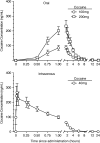Bioavailability and Pharmacokinetics of Oral Cocaine in Humans
- PMID: 29462364
- PMCID: PMC5952935
- DOI: 10.1093/jat/bky007
Bioavailability and Pharmacokinetics of Oral Cocaine in Humans
Abstract
The pharmacokinetic profile of oral cocaine has not been fully characterized and prospective data on oral bioavailability are limited. A within-subject study was performed to characterize the bioavailability and pharmacokinetics of oral cocaine. Fourteen healthy inpatient participants (six males) with current histories of cocaine use were administered two oral doses (100 and 200 mg) and one intravenous (IV) dose (40 mg) of cocaine during three separate dosing sessions. Plasma samples were collected for up to 24 h after dosing and analyzed for cocaine and metabolites by gas chromatography-mass spectrometry. Pharmacokinetic parameters were calculated by non-compartmental analysis, and a two-factor model was used to assess for dose and sex differences. The mean ± SEM oral cocaine bioavailability was 0.32 ± 0.04 after 100 and 0.45 ± 0.06 after 200 mg oral cocaine. Volume of distribution (Vd) and clearance (CL) were both greatest after 100 mg oral (Vd = 4.2 L/kg; CL = 116.2 mL/[min kg]) compared to 200 mg oral (Vd = 2.9 L/kg; CL = 87.5 mL/[min kg]) and 40 mg IV (Vd = 1.3 L/kg; CL = 32.7 mL/[min kg]). Oral cocaine area-under-thecurve (AUC) and peak concentration increased in a dose-related manner. AUC metabolite-to-parent ratios of benzoylecgonine and ecgonine methyl ester were significantly higher after oral compared to IV administration and highest after the lower oral dose. In addition, minor metabolites were detected in higher concentrations after oral compared to IV cocaine. Oral cocaine produced a pharmacokinetic profile different from IV cocaine, which appears as a rightward and downward shift in the concentration-time profile. Cocaine bioavailability values were similar to previous estimates. Oral cocaine also produced a unique metabolic profile, with greater concentrations of major and minor metabolites.
Figures




References
-
- Rowbotham M.C., Jones R.T., Benowitz N.L., Jacob P. III (1984) Trazodone-oral cocaine interactions. Archives of General Psychiatry, 41, 895–899. - PubMed
-
- Chow M.J., Ambre J.J., Ruo T.I., Atkinson A.J. Jr, Bowsher D.J., Fischman M.W. (1985) Kinetics of cocaine distribution, elimination, and chronotropic effects. Clinical Pharmacology & Therapeutics, 38, 318–324. - PubMed
-
- Cone E.J. (1995) Pharmacokinetics and pharmacodynamics of cocaine. Journal of Analytical Toxicology, 19, 459–478. - PubMed
-
- Van Dyke C., Jatlow P., Ungerer J., Barash P.G., Byck R. (1978) Oral cocaine: plasma concentrations and central effects. Science, 200, 211–213. - PubMed
-
- Wilkinson P., Van Dyke C., Jatlow P., Barash P., Byck R. (1980) Intranasal and oral cocaine kinetics. Clinical Pharmacology & Therapeutics, 27, 386–394. - PubMed
Publication types
MeSH terms
Substances
Grants and funding
LinkOut - more resources
Full Text Sources
Other Literature Sources
Medical

